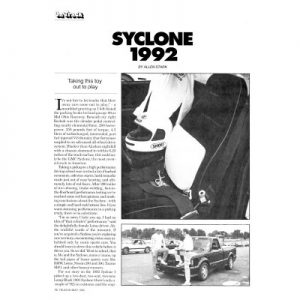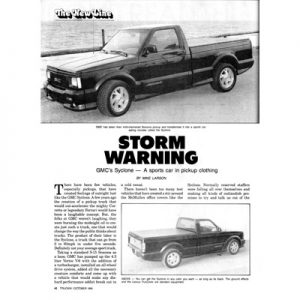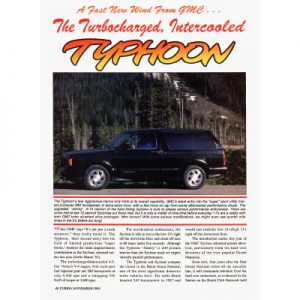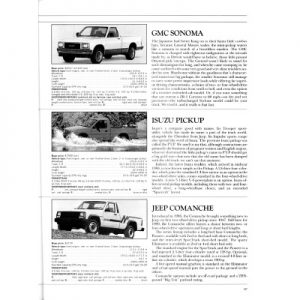Truck & Sport Utility
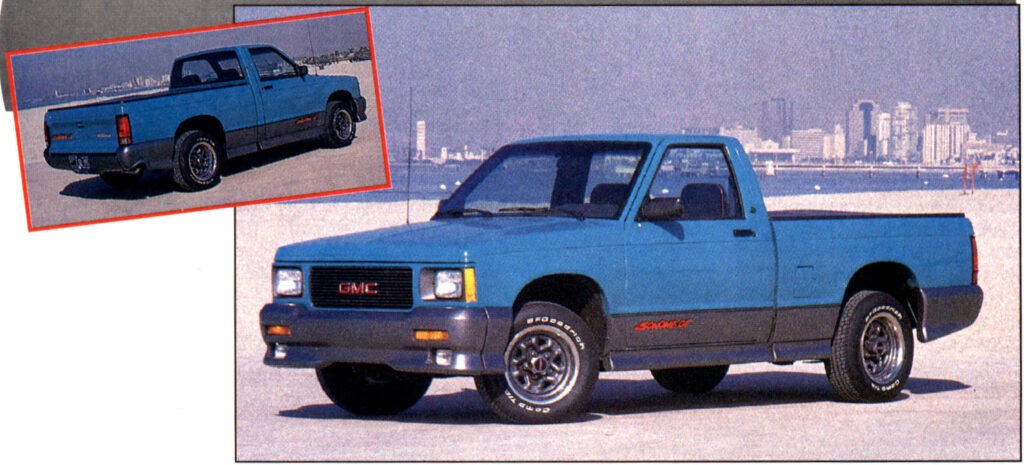
Grab a GMC Sonoma while you can, because the sun is setting on this great truck after just one year on the market.
If you’re in the market for a tire-shredding Syclone, but don’t have twenty-five to thirty grand in loose change rattling in your pockets, check out its sibling: the Sonoma GT. But regardless of which one takes your fancy, you had better act fast. The bad news is that GMC is phasing out both trucks. The good news is this decision may turn both of these pocket-rockets into full-on collectibles. We’re not saying they will become the Shelby Cobra ACs of the truck world and fetch six-figure auction prices, but we are saying there is potential.
Visually, the Sonoma GT and Syclone look as though they came from the same mold, sharing the same ground effects, grille, tonneau cover and color combos of Black, Frost White, Bright Teal, Aspen Blue Metallic and Apple Red. Underneath the skin, however, is where the differences become apparent. While the Sonoma GT relinquishes the Syclone’s turbocharged and intercooled engine and all-wheel-drive traction system, it wasn’t left high and dry by any stretch of the imagination. The engineers at GM really did their homework when they designed a high output version of the Vortec V-6, a.k.a. the L35. Although not as quick as the Syclone, when you drive a Sonoma GT off the dealer’s lot, you have ten grand in hand and a more rounded truck for your buck.
The biggest debate about the Syclone centered around its payload towing capacity. Syclone has a feathiy 500-pound payload rating because hauling was sacrificed for handling. When it comes to towing, forget it. The Syclone was never issued a towing capacity because in heavyduty towing situations the turbo would be under boost for an extended period of time, generating excessive operating temperature. The naturally aspirated GT can haul 950 pounds of cargo, tow 6000 pounds worth of trailer and still accelerate like a race horse breaking from the gate.
The heart of the truck is the (new for ’92) L35 high performance V-6 engine that pumps out 195 horsepower and 260ft/lbs of torque at 3600rpm. The beauty of this motor is that it may be possible to make it more powerful than the Syclone’s. When creating the Syclone, GM bolted a turbo to a standard Vortec 160-horse V-6. Now you can do the same, but with the L35 you’re starting with more eggs in your basket.
Even from idle the engine is eager to get down to business. Nudge the 4L60 4-speed into “Drive,” stomp on the accelerator and the GT’s fenderwells begin to bellow smoke—right foot control is a must. The truck pulls hard enough off the line, but when second gear pops in, brace yourself. The GT really digs in and goes, pinning your shoulders to the seatbacks. At speed throttle response is excellent, thanks to the L35’s central- port fuel injection and internal balance shafts. While performance-minded automatic trannies have come a long way, a 5-speed manual would have been at the top of our wish list. It would give the driver control of the shift points and more revs mean more performance.
After gathering gobs of seat-of- the-pants feedback, we took the Sonoma GT to Los Angeles County Raceway (LACR) to evaluate the truck’s potential with a stopwatch. The Sonoma was up to the challenge, screaming down the strip in 16.65 with a terminal velocity of 81mph. When corrected for altitude (LACR is at an elevation of about 3000ft.) the GT recorded a time of 16.12 topping out at 84mph. With a set of headers and a free-flowing exhaust system this truck could easily break the 15-second barrier. It should be noted that even during the footstopping performance testing the truck averaged 21.2mpg. This was right in line with its EPA rating of 18 and 24.
With the Sonoma GT’s straight-line performance figures duly noted in our logbook, it was time to wring the truck out on the twisties. Again, we tip our hats to GM’s team of engineers. They put together suspension components that work in concert, allowing the truck to corner like it was on rails, yet still deliver a cushy, forgiving ride. This balance was attained by using torsion bars up front and a two-stage leaf spring setup in the rear. A set of specially-valved Bilstein shocks and P215/65 x15 BF Goodrich Comp T/As add to the GT’s sure-footedness. When put to the test the suspension is easy to anticipate. At the apex, the Sonoma tends to over-steer, but modulating the throttle brings the truck back on track. The combination of the powerful engine and a more-than- able suspension give the driver the confidence to search out the edge of the truck’s performance envelope. As refined as the Sonoma’s road manners are, the truck is designed for the general public, not performance enthusiasts. The GT would really corner like a slot car if it were dropped three or four inches all around and shod with bigger, even more aggressive rubber.
The interior serves as further proof that the Sonoma GT is a direct descendant of the Syclone. Except for the interior badging and the lack of a boost gauge under the seven on the tachometer, you’d swear you were sitting in a Syclone. The bucket seats are supportive enough, but they don’t recline, which makes getting comfortable on long trips a real chore—the problem is the seatbacks angle in at the top of the seats, which is right between the shoulder blades for anyone over six-foot.
The gauge cluster—which includes a 100mph speedo, 7000rpm tach, plus fuel level, oil pressure, coolant temperature and amperage gauges—exudes sporti ness, all the while reassuring you that this is more than a work truck. The dials are clear and easy to read and all the driver controls are well within reach. Our tester was outfitted with an optional Delco AM/FM CD player stereo that helped make the miles roll by quicker. The GT package includes air conditioning, dual electronic mirrors, cruise control, power steering and interval wipers.
The Sonoma GT is an interesting proposition. It has potential as a performance sleeper and as a wise investment. With improved breathing and/or forced induction, it could be a real pavement scorcher. Perhaps discontinuing the Sonoma GT will prove to be the best thing that could have happened. Now, as you appreciate its performance, “it” appreciates in value.

